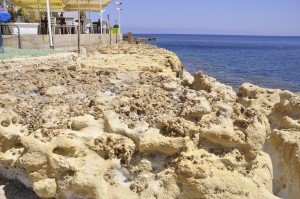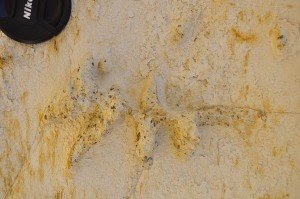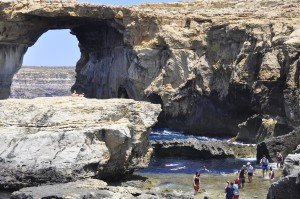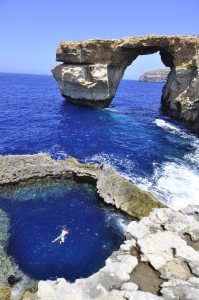If one word could sum up the Mediterranean island nation of Malta, it would be “limestone”. Limestone has shaped the islands’ topography, their economy and possibly black bank accounts. It has also made Malta a paradise for carbonate geology studies – and diving.
In this article, I will take a look at them all. But, let’s start with the (literally) fundamentals: The geology itself. Get ready to get nerdy.
Malta lies on a large carbonate platform that stretches northwards from Africa and also comprise Sicily. Geo-wise, Malta is thus a part of Africa, and the islands are just the youngest tops of the rocks that peak above sea surface. They were deposited from the Upper Oligocene through Upper Miocene, from ca 20 to 8 million years ago. On the geological time scale, Malta is a toddler.
The lithostratigraphy – geo-speak for making a system of the rock layers – on Malta has three main groups, and their development was controlled by changes in the sea level of the Mediterranean through time. Sea level, in turn, is the result of the complex interplay of how much water came through the Gibraltar strait relative to evaporation, and by sediments dumped from the erosion of landmasses lifted up when Africa collided with Europe to produce the Alps.
The lower of the three levels is the Lower Corralline limestone, made up of carbonate sand and gravel, mixed with shell fossils. The carbonate sediments were originally living organisms, such as coral reefs, shells, or as very fine-grained plankton – probably on what now is Sicily. Then, these rocks were eroded, flushed south to Malta by high-energy waves and currents, and re-deposited as sand and gravel in shallow water. Some beds in the Lower Coralline consist nearly solely of shell fossils, ground to fragments by the eternal wave movements.
The Lower Corraline limestone is hard and resistant to wear and tear, and form steep and vertical cliffs along the coast. On the coast northwest of Marsalforn on Gozo, it has beautiful crossbeds; where each bed consists of thin layers that dip in the direction of the current. It was Murphy’s Law 2.0 that I saw these beautiful features from a wet diving rib where carrying the camera would be foolish. Arrgh!
The middle interval is the soft of the trio: The Globigerina limestone is composed nearly solely of planktonic carbonate, and has its name from the Globigerina foraminifera, a very tiny crustacean. Pure and fine-grained, this limestone has a distinct yellow-greyish color. It is used to construct buildings, aquaducts, pavements, basically everything, and Maltese towns therefore have the same yellowish-greyish color from tip to toe, as if everything was built by Lego bricks of the same color. Because limestone slowly dissolve from acids in rain, some buildings have had parts of their walls washed away.
The limestone is pure because it was deposited deep, probably 200 meters, where very few organisms would mess it up before it consolidated to rock.

Marsalforn bay, with houses residing on the soft Globigerina limestone. Do not invest in seafront real estate if your investment horizon exceeds a few hundred years.

Yellow-greyish Globigerina limestone in buildings as far as the eye can see. The image is taken in Gozo’s capital, whose name in Maltese is Ir-Rabat, but was renamed to Victoria to suck up to a certain Queen. In the background, the mighty Ta’Pinu cathedral.
However, periods of shallower water interrupted the deep calmness, and with shallow water came organisms that buried in the sediments. Their burials and tunnels, “bioturbation”, in geo-speak, left coarse dark nodules that almost entirely make up some beds. My muggle – a.k.a. non-geologist – travel mates were quite surprised to learn that the dark blobs in the light rock were literally old faeces from slimy creatures that lived in the sediments before they became hard rocks; they ate not-yet-solidified carbonate rock in one end, and leaving brown blobs at the rear.
The longer a layer is left in shallow water, without being buried by new sediments, the more time the creatures have to make burials. In the bay of Marsalforn, our base at Gozo, one can see how a homogeneous limestone gets more and more burials, ending in a layer that is nearly only burial nodules – before sea level suddenly rose again, and abruptly changed to only yellowish again.

During lowstands, burying organisms create tunnels in the sediments; most close to the surface. some deeper. Then, fast sea level rise drowns the burial organisms, until new ones start over again at a shallower level.

Benches in the Globigerina limestone, that highlight how periods with calm deposition have left light limestone with litte bioturbation, interrupted by low-stands with heavy treatment by the slimy creatures.

Hard layers composed nearly solely of burials, in the harbour of Marsalforn. This is some solid accumulation of old poo!

A beatutiful spiral burial in the Globigerina limestone, including the mandatory lens cap for scale.
Above the Globigerina is the thin Blue Clay. It is the softest rock on Malta, but very important, because it consists of very fine grained particles of clay minerals and carbonate, which make it impermeable. It catches water that sinks down through the porous rocks above, and forms the floor of a precious freshwater table.
Finally, the Upper Corallian limestone is a lookalike, although thinner, of its older sibling and with the same high-energy deposition environment. On Gozo, this hard limestone stands out as caps with steep cliff sides and flat tops, above the softer rocks beneath. Therefore, citadelles for defense reside on top of these high parts of the island. Actually, after an Arabian pirate attack in 1556 kidnapped nearly the whole population, the remaining gozitans for a long period stayed inside the citadels during night and went out only to work on the fields during the day.
By now, you have already seen glimpses of how the geology of Malta influence people’s life. Let’s take a closer look.
Water has always been scarce on dry Malta. It sinks through the porous limestone and therefore, the country depends on ground water. The largest fresh water body is at level with the sea, in the Lower Coralline: The lighter fresh water floats on the salt water. But, heavy use of the ground water seriously threatens the future of the fresh water supply. Much fresh water comes from by reverse osmosis of ocean water, but the energy-intensive, oil-fueled process costs five times as much as ground water, and therefore many illegal wells tap into the ground water reservoir. As a result of the water scarcity, Malta produces only around one fifth of the food it consumes, according to the wicked pedia.
Malta has no natural resources. No metamorphism, no volcanism circulated fluids saturated with metals. No ore, no coal, no geothermal, no energy resources. Sicily with the famous Mt Etna and other active and extinct volcanic fields lies just to the North, and the volcanic Pantelleria island to the SW – but on Malta, nothing.
Enter oil? Malta lies on the Pelagian block, a northward extension of Africa that also comprises large oil fields on Sicily. Just to the west is Tunisia and to the South is Libya with their well known large resources. Thus, there is no reason Maltese waters could not hold hydrocarbons.
The first exploration well, Naxxar 2, was drilled onshore back in 1959. Altogether 12 wells are drilled on- and offshore, the last in 2002. Offshore Alexia 2 found oil in 1984 and onshore MTZ 1 found gas in 1999. These were both technical discoveries (oil speak for “too small to make money”), but important as they proved a working petroleum system.
In recent years, a number of oil companies have got acreage offshore Malta. A first well, Hagar Quim 1, will be drilled south of Malta in 2014 by Genel Enerji and its partner Mediterranean Oil and Gas. These wells will go into deeper and older rocks than those exposed on the islands themselves, but that are analogues to fields in Libya, Tunisia and Sicily. Hagar Quim 1 searches for a Lower Eocene to Paleocene carbonate-clastic reservoir. Upper Cretaceous reefs, and structural traps on Late Triassic-Early Jurassic platforms are other potential targets.
As a sidebar, it is tempting to link some Maltese businesses to the lack of natural resources. The Maltese turned to become a prominent shipping nation – and a tax haven. At least, Malta has avoided the curse of natural resources!
Finally, let’s, literally, dive into the lighter sides of Maltese life: That under water. Malta, and especially Gozo, is regarded as the best place to dive in the Mediterranean. Malta has protected its fish stock fairly well. Karst caves and sinkholes along the coast create spectacular landscapes above and under water. Among them, the Cathedral cave is a huge dome with access only below sea surface. Breaking the surface inside the cave, the dome is laminated by sunrays through small openings in the wall. Any sound, word, wave echoes from the walls. Then comes the swim out again, through the large, mighty door opening into the big blue…
Even more spectacular is the Azure window. It is a sinkhole, where the sea has also torn away the lower part and connected it to the sea. The upper part consist of a hard ground, a well cemented fossil rich layer, and creates a natural rim around the deep pool. A popular escape destination, the Blue Hole is chock full of bathers in the upper part and divers at all levels. Just close is the large arc, standing on a pillar in the sea. Once, it was likely a cave, now only one last pillar is standing. It was a mighty experience to dive into the big blue hole, and then see the shadow of the arc above, with waves smashing onto the pillar. Below the arc, the sea floor was covered with boulders that fell down from it during winter season, a reminder that the pillar is slowly being torn away. Geology may look eternal, but is certainly not…






Veldig stilig side! :-)
Takker for det! Det er mer geologi nedover :)
We have had 3 holidays on Gozo but have never found information of this detail and clarity. We are in a U3A geology group so we can talk properly about our latest visit with them. The azure window is a great loss but geology in action!
Pingback: Malta article now in GEO ExPro! | Adventures in geology - Karsten Eig·
Pingback: Light Beer: the Cretaceous’s so bright I gotta wear shades! | Adventures in geology - Karsten Eig·
Dear Karsten,
I have just discovered and read your very interesting page. I’m visiting Malta for the first time and have an interest in the rock formations there. I write a blog (normally on permaculture garden, or other such things in Ireland – over 300 followers), and I would like to repeat one or two sentences from your pages here when I do a write up on Malta, of course quoting your name and webpage. Would this be all right with you?
Many thanks.
Agnes
Hi Agnes!
You are welcome cite a few sentences from the article, provided you quote the name and links to my article. Good luck! :)
Will certainly do as you ask, many thanks.
Agnes :-)
Pingback: agoyvaerts·
Karsten,
Please could you tell me what the Azure window in Gozo is made of?
Thanks
Ernest
The window is a karst hole in the Globigerina limestone. water flowing through the ground dissolved the limestone and made a cave, before the sea eroded into it and removed one of the walls. Hope it helps!
http://www.emwis-mt.org/documentation/context/physical%20factors_files/Geology.htm
Sadly the window is no longer there. It was swept away by huge waves this past winter.
the azure window is no more
Yes, it is very sad that it collapsed, and Malta lost this landmark.
I am a 70 yr old retired accountant. I know little abut geology but am interested. I absolutely loved your article! You have a real talent for writing.
Glad to have found your article as it answered my husband’s question – How old? when editing my work. I had stated, Gozo, Malta and Comino islands were once joined together. I am researching the Maltese islands and those of the Anglesey archipelago together with the different methods used by different people to” interpret” them. Your article was enjoyable, easy to understand, informative and made me chuckle. It also put me right back there looking at the buildings and the fossils underfoot at Dwejra Bay. It’s what interpretation is all about -attracting attention, memories, how you make people feel, current accurate information and the telling of stories. [Gwych = Brilliant] Agree with Rebecca’s comment above.
The Maltese Islands were connected together at a point if I recall correctly. They were also connected to Sicily through a land bridge which formed as the Mediterranean sea-level deceased drastically. This land bridge formed during the Last Glacial Cycle some 20 ka. Evidence for this lies in animal and human remains which were found in Malta and Sicily.
https://www.researchgate.net/profile/Mariacristina_Prampolini/publication/281268364/figure/fig6/AS:316830699802629@1452549733627/Reconstruction-of-the-evolution-of-the-Maltese-palaeolandscape-after-the-LGM-from-20-ka.png
Pingback: European Capitals of Culture 2018: Malta’s La Valetta and the Dutch city of Leeuwarden - Stone-ideas.com·
Pingback: Europäische Kulturhauptstädte 2018·
Fabulous article…thank you!
My first time on Gozo/Malta and my mind was full of questions about its rock formation and fossils, thanks to your wonderful write up I now understand how it all began. So very interesting.
Thank You!
I will be in Malta for 5 months in 2019 and found this article wonderfully interesting and completely accessible. Thank you for writing such a clear, informative, and occasionally humorous piece!
Loved this, even my 11 year old started asking questions – job done – we’ll done you.
Smiles all round :-)))
Dear Karsten,
Thanks for the insight. Would you say that drilling water wells on the beach in Gozo may find Karst caves and sinkholes which may cause the drilling string to fall into ?
Regards,
RM
Hi Ralphi!
I do not know the karst distribution on Gozo in any detail. But, in general, I think there would always be a risk while drilling on Malta and Gozo, that a well could strike a karst hole or cave.
I love Gozo and this article was fascinating. Thank you
:) <3 !
Visiting Malta for the second time, this summer, but this time I am doing homework on the geology of the islands. This is great! thank you!
Nick
Very interesting article! When you wrote “The Coralline limestone can consist nearly solely of fragments of Shells” and got that picture, what type of shells were you referring to? Echinoids like Scutella? .
It’s some years since I wrote the article, so honestly, I do not know…